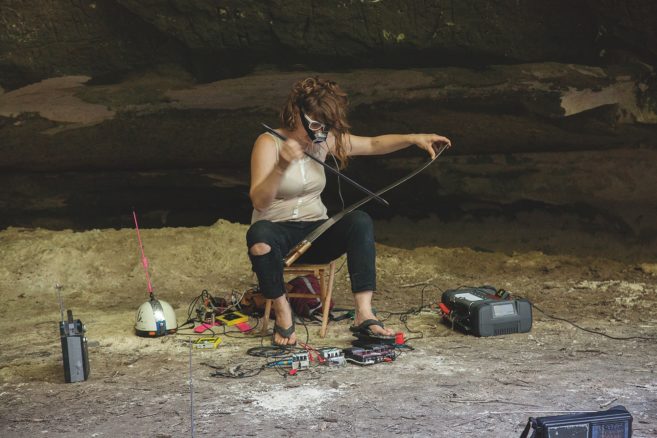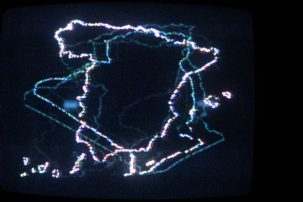Art has the power to urge viewers to consider their responsibility in ecological crises. In New Brunswick, where I live, megacorporations both clear-cut forests and fund the arts. But artists, writers and poets are pushing back in their own complex ways, here and elsewhere.
This much was evident at “The Ark: Art Installations at Wood Point, New Brunswick,” an arts event from July 27 to August 11 on the property of visual artist John Haney and poet Amanda Jernigan. It featured installation, sculpture, print, photography and performances by 22 artists in forests, fields, shoreline and a newly built woodshed gallery—all acting as an alternative to the institutionalized art model.
“I’ve always loved hearing and telling stories,” says Haney. “New stories begin every day, then begin the process of being refined and then integrated into the place. That’s what I’m doing here, is beginning some new stories.” Beginning those stories involved taking risks financially—both for the artists and their hosts. Not having any funding or support to pay artist fees, Haney and Jernigan opened their home and extended their property to all 22 invited artists, and also offered to cook, feed, and house the artists on site.
Jernigan writes in the exhibition catalogue, “if you don’t / put out to sea / the sea will come / to you my daughter”, indicating another kind of risk in living among climate crises. To an extent, Jernigan and Haney have seen the water come to them. Last fall’s extreme weather saw 50 millimetres of rain in a single day, followed by 100 kilometre-per-hour winds. Water filled the basement and poured through the roof. The barbecue was strewn 20 feet across the lawn. A dozen spruce and fir trees were lost; the road to town was washed out.
After that storm, Haney and Jernigan rebuilt, slowly—with “The Ark” being a part of that. In wide scope, the intentions of “The Ark” illustrate a need for community, active environmental responsibility and return to land-based art practices. At the same time, the project raised questions for me about what communities were absent from the project. Both of these aspects stayed with me as I toured the site, and afterwards reflected on it in my own New Brunswick home.
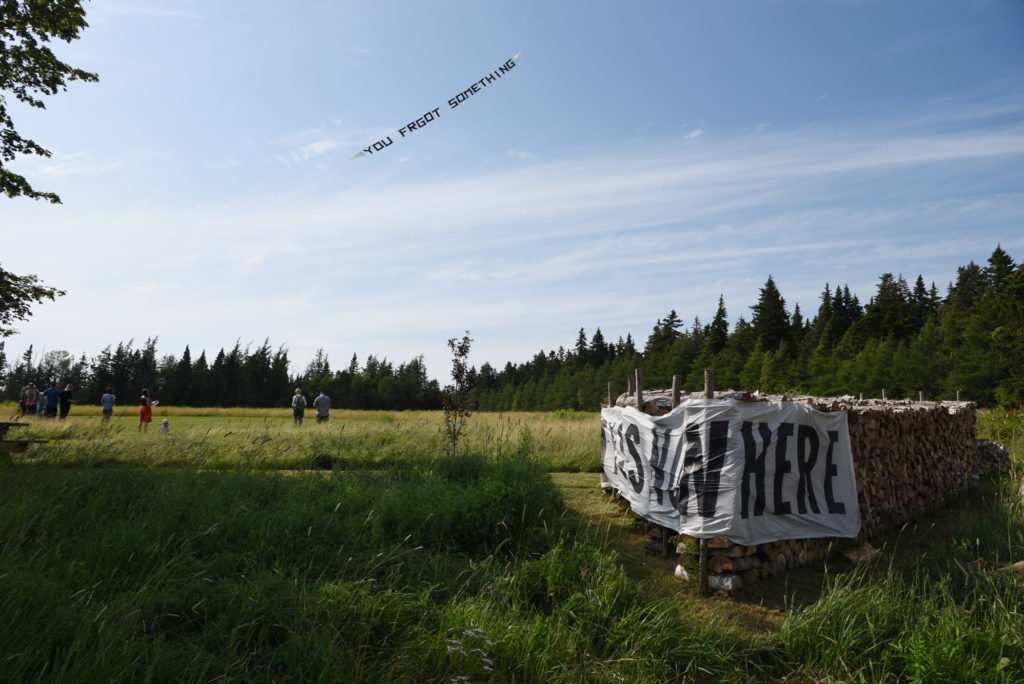 Among the installations in the Ark at Wood Point was a floating kite by Andrew Maize and Amanda Jernigan titled You Forgot Something (2019). A solo work by Maize was installed on the woodpile. Photo: John Haney.
Among the installations in the Ark at Wood Point was a floating kite by Andrew Maize and Amanda Jernigan titled You Forgot Something (2019). A solo work by Maize was installed on the woodpile. Photo: John Haney.
Arriving in Wood Point, my partner and I looked up to see Andrew Maize and Amanda Jernigan’s You Forgot Something (2019), a kite made of nylon and recycled spinnaker, soaring in the fields. (The “o” in “forgot” was one of the things missing.) Then we entered the woodshed gallery, where Haney greeted us and offered to give us a guided tour of the property and site-specific work.
While Haney spoke about “The Ark” as a catalyst for turning his woodshed into a gallery space, I considered Shary Boyle’s Untitled, from her Porcelain Fantasy Series (2005). Boyle has a surreal, magical quality to her work, both playful and dark—kind of like the Ark. As a displaced Newfoundlander, though, what resonated with me most in the gallery were the six prints from Will Gill’s Lion’s Den (2019). These striking photographs were shot on the open ocean, and in a cove of the same name in Newfoundland. That cove was once home to a population of 50, and was resettled in 1950. Like “The Ark” itself, Gill’s work speaks to migration, change and survival.
“If an ark is something that affords protection or safety,” Gill writes, “it can also be thought of as a means for freedom. This photographic series follows an unidentified trio in their journey to start over.” In a way, like the subjects in Gill’s photographs, we are all in a proverbial boat, starting over, I think.
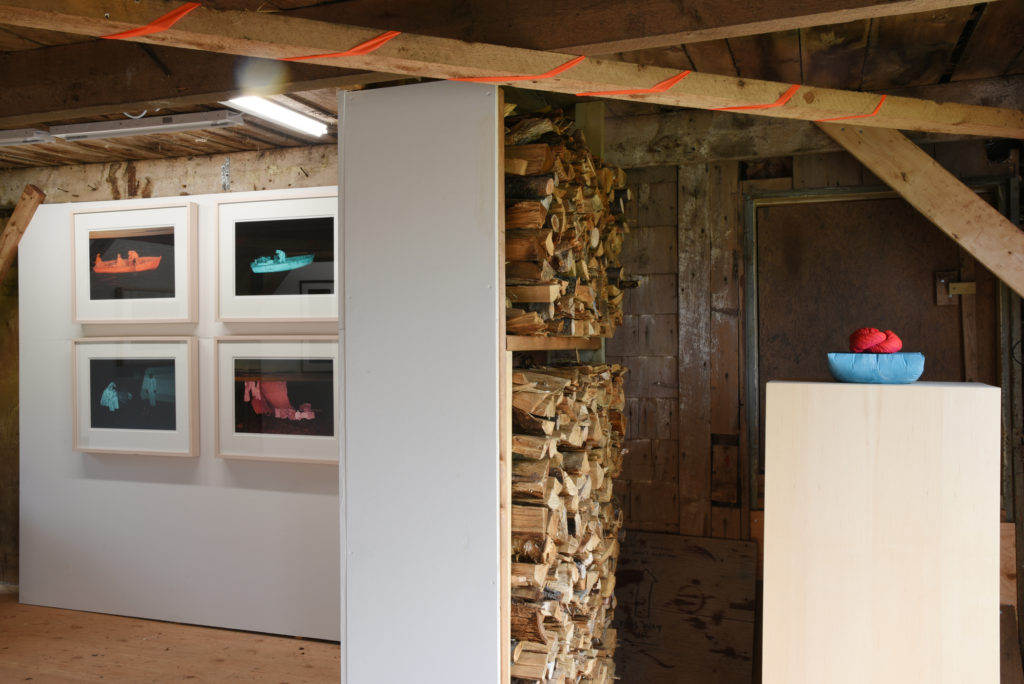 A partial view of the woodshed gallery at Wood Point, installed for the Ark. At left is work by Will Gill, at right work by Svava Juliusson. Photo: John Haney.
A partial view of the woodshed gallery at Wood Point, installed for the Ark. At left is work by Will Gill, at right work by Svava Juliusson. Photo: John Haney.
Haney, my partner and I have all recently relocated to different parts of New Brunswick in order to grow roots, nest and create our homes. In this context, I read “The Ark” as an act of community building that is deeply necessary.
As the sky darkened, Haney led us to the lower woods where we saw a white sail hung from trees in a birch grove off the main trail. The sail was part of Lacey Decker Hawthorne’s Clew (2019), a trio of wooden frames evoking a small house, tied together with a single red thread. Nestled into the lower woods, Clew spoke to the nautical mythology of “The Ark,” and a longing for home.
“A single string of red winds its way through the houses and the forest, and anchors itself to the mast, providing bearings back home,” Hawthorne has written. “The work draws on Titian’s painting Bacchus and Ariadne, where Ariadne, having just woken, reaches toward the horizon where Theseus’ ship is under full sail, having departed in the night.”
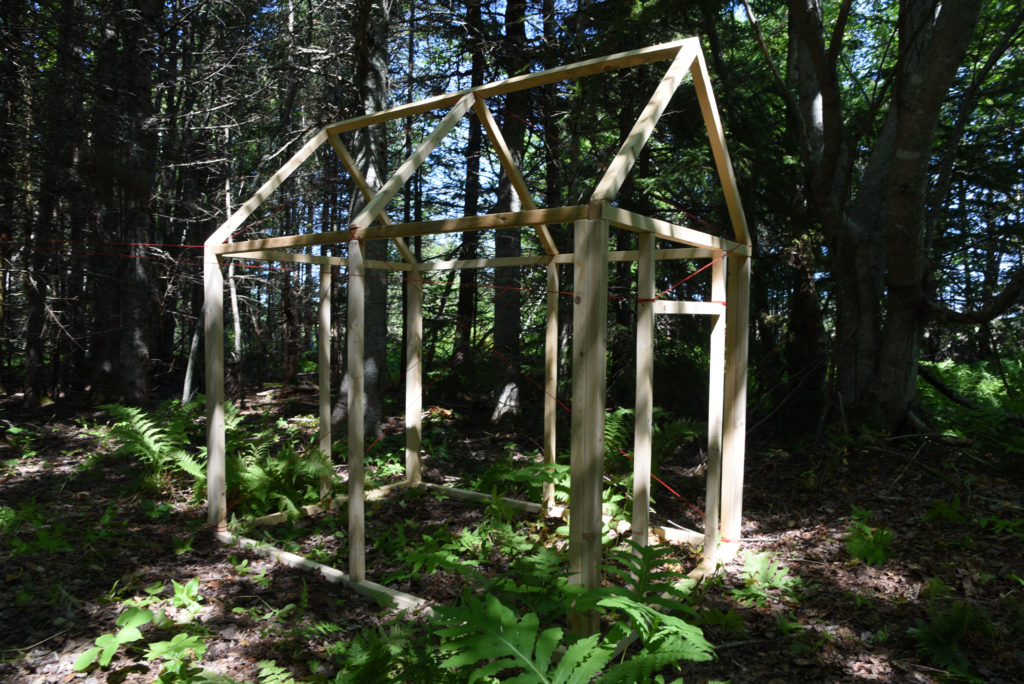 A partial view of Lacey Decker Hawthorne‘s Clew (2019) in the Ark at Wood Point. Photo: John Haney.
A partial view of Lacey Decker Hawthorne‘s Clew (2019) in the Ark at Wood Point. Photo: John Haney.
Poetry, storytelling and narrative techniques forms were essential to “The Ark,” woven throughout the programming in ways both obvious and subtle.
Amy Siegel and Paul Henderson’s large text Let Me Be Your Plus One was made of fellow artist John Murchie’s ceiling panels. Installed in marshes where the land met the water, it was both tongue-and-cheek and commandingly coy. What would it be like to arrive by boat and see this text? What does it suggest when we see it from the shoreline?
In conversation with Siegel and Henderson’s piece was Haney’s Landfall (2019). This found antique plough, embellished with 24k gold leaf and 66-foot chain, and installed at the high-tide line of the Bay of Fundy, spoke to the former owner of Haney and Jernigan’s house, Ernest Barnes—a decendant of John Barnes, who landed on an open boat on the shore in 1768. Barnes had rowed away from Rhode Island, and was granted some three thousand acres by the English colonial government.
The plough used in Landfall was leaning against the woodshed when Haney moved into the house with his family last year. In this installation, he integrates references to the plough as a measuring device. Indeed, the plough, and its related measure, the chain (66 feet long), plotted land in England, and by extension the British Empire, and became the basis for the mile, the rod, the furlong and the acre. It’s a tool powerfully bound to the colonialism that made Barnes’s landing, and land ownership here, possible.
 A painting by Patrick Cruz installed at Wood Point as part of the Ark. Photo: John Haney.
A painting by Patrick Cruz installed at Wood Point as part of the Ark. Photo: John Haney.
Haney’s piece, like many in “The Ark,” is powerful and provocative—yet it speaks to only one historical narrative of these lands and waters. Perhaps if it was met by Indigenous artists’ work, or if there was some acknowledgement or engagement with the story of Glooscap, the Mi’kmaq legend that references the reason behind the rise and fall of the tides, then Landfall could have been more fully realized and contextualized.
While mythology was a central theme in “The Ark,” encouraging viewers to connect to collective consciousness and observe ancient means of sustainable production, it could also be seen as promoting a colonized view of land and “going back” to land. The desire to “return” to the land is natural, I think—yet how can we collectively “go back” to the land, or return to rural ways, without acknowledging this country’s complex history, particularly that of dispossession of land and mistreatment of Indigenous peoples?
Being titled for a Christianized narrative, “The Ark” invites viewers to start anew—to rescue what they need, and leave the rest behind. But what about who was here before? What about responsibility to Mi’kma’ki? And also, what about the Acadian artists in the area?
In reality, for artists and viewers to protect the environment and gather together in crisis, we must invite Indigenous artists and land protectors, and engage with Indigenous world views.
As we stood by the water’s edge with Haney, he acknowledged the land as Mi’kma’ki, and I wondered aloud why there were no Indigenous artists involved in “The Ark,” as it seemed like a significant oversight—and personally, a missing link for community-building. Haney agreed: if “The Ark” has another year, which he hopes to create, he would connect with Indigenous artists, poets and Elders in the area to decolonize—not as a means of tokenization, but as an offering and invitation to connect and share, and most importantly, honour the traditional lands and waters of Mi’kma’ki.
“Yes [in the future we would invite], Mi’kmaq artists. Not to mention Acadian artists. That would certainly be the plan,” says Haney. “My idea of inviting close friends was that they would be on board to start something at the base level, and once that’s happened, and it has, and I can make things more official, get funding, and open it up to a wider application/curation process; I would also have more confidence asking people I don’t know as well.
“Improvements are always necessary and something I strive for,” Haney responded. “Now that we’ve been back for a year, I’m excited to broaden my network and connections, and my hope and intention is to get to know more artists from all backgrounds, all across the Maritimes.”
Part of Haney’s acknowledgement of the complex history of this territory comes up in a text published in the homemade, hand-printed exhibition essay.
“This region had been pried away from the Mi’kmaq, freshly scoured of Acadians, and Britain’s colonial government was all too happy repopulate it with English-speaking settlers,” Haney writes in that essay. “The original Barnes land grant was three thousand acres. What we bought nearly two hundred and fifty years later was the final fragment of that grant.”
 An installation by Bucky Buckler in the Bay of Fundy by Wood Point during the Ark. Photo: John Haney.
An installation by Bucky Buckler in the Bay of Fundy by Wood Point during the Ark. Photo: John Haney.
There is an incredible possibility for future conversations if “The Ark” continues. And for the first crack at a quasi-arts festival at Wood Point, “The Ark” held extraordinary poetic potential. The site-specific work spanning the woodshed, the upper field, the lower woods, and the bay insisted viewers engage with our current environmental crisis and created an alternative to the colonial art model.
“Mythology cuts through deep time, in terms of human existence. This place we live in, Wood Point, has had many names over the past 15,000 years, and many people have lived here,” says Haney. “We are the scratch of a fingernail on top of that. What I’m interested to do is to pay tribute to those histories that have been piled on top of each other: a vertical conception of time, as John Berger might define it. Listen for the past voices, imagine the activities that happened.”
Certainly, there is a lot in this place to experience—even if it’s not always recognized by colonial powers or by urban art “centres.”
“I wanted to make something happen on the margin, a place where I’ve always felt more comfortable. Destabilize things. We have to start staying closer to home and appreciating what’s under our feet,” says Haney. “I like the idea that great things happen in all kinds of places. The magic of ‘The Ark’ was partly the art, but the real star was the place. This event couldn’t have happened anywhere else.”
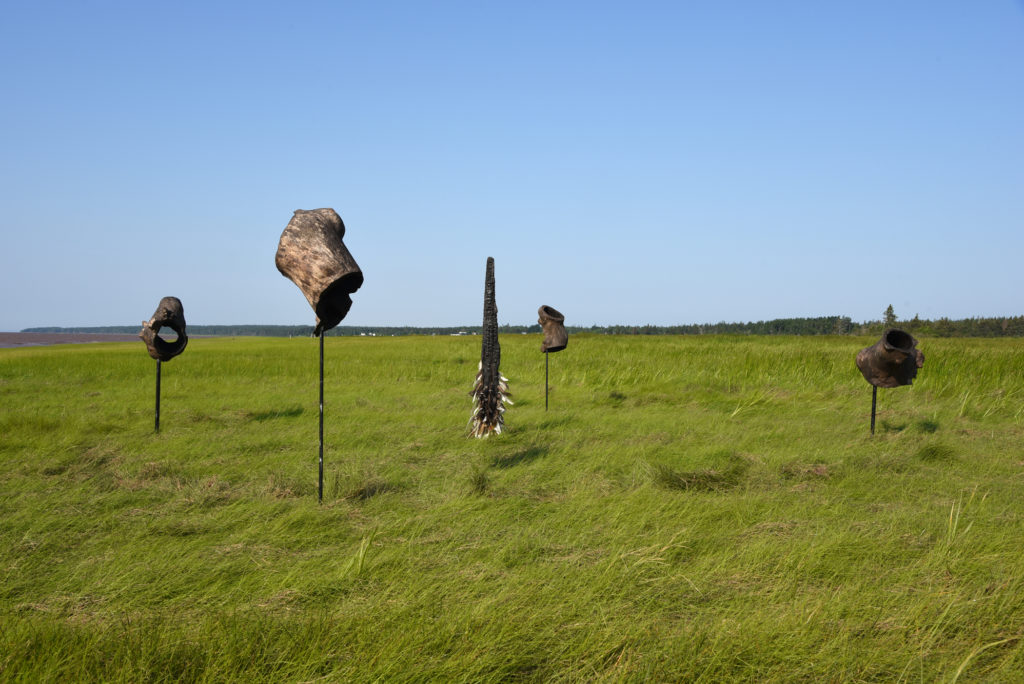 Installation by Shamus Griffith in the Ark at Wood Point, New Brunswick. Photo: John Haney.
Installation by Shamus Griffith in the Ark at Wood Point, New Brunswick. Photo: John Haney.

